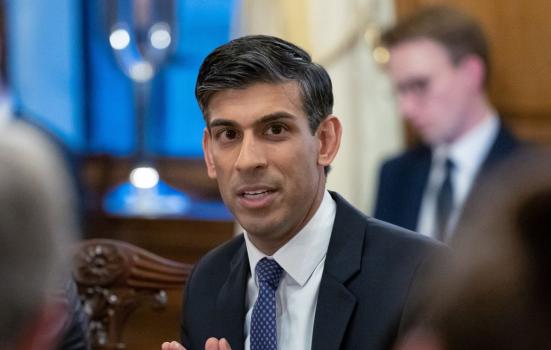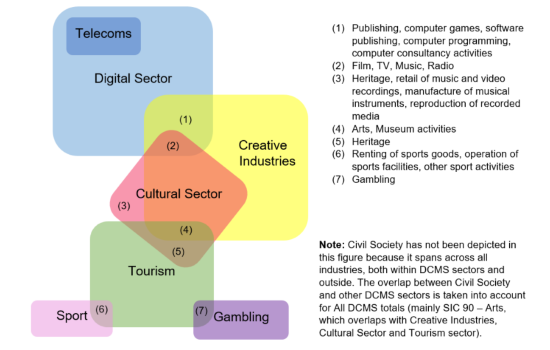An additional £77m will be invested by government to help grow the creative industries but theatres, museums and galleries miss out on financial support.

Wikimedia/Creative Commons
Efforts to boost the economic value of the creative industries by £50bn in the next seven years will focus on three strands of work and financial support for the "fastest growing sectors", the government has said.
The delayed Creative Industries Sector Vision, published today and backed with £77m of new government money, outlines three 'goals' in the areas of growth, workforce, and wider impact.
The majority of the new investment (£50m) will go to supporting the next wave of the Creative Industries Clusters programme, which aims to drive innovation and create products and experiences such as immersive tech and AI that can be marketed around the world.
READ MORE:
- Frazer vows to grow creative industries by £50bn
- Frazer: Creative industries 'key priority' for government
Meanwhile, DCMS will expand Arts Council England’s Supporting Grassroots Music Venues Fund, providing an additional £5m over two years to support around 400 grassroots music venues projects. The vision also says the government will 'deliver' the Music Venue Trust's £3.5m Own Our Venues pilot.
And funding for the Music Exports Growth Scheme, which provides grants to support touring and help emerging musicians break into new global markets, will be expanded to £3.2m over the next two years.
The budget of the Create Growth Programme will also be boosted by £10.9m to support potential high-growth creative businesses.
And the Sector Vision also commits the government to a new "creative careers promise" to open up more opportunities, particularly for young people, to pursue careers in the creative industries.
Cultural sector misses out
Despite being among the nine subsectors of the government's definition of creative industries there is no new funding for museums, galleries, libraries, performing or visual arts.
 DCMS graphic showing overlap between cultural sector and creative industries
DCMS graphic showing overlap between cultural sector and creative industries
Image: UK Government.
"In this Sector Vision, we cover all the creative industries but with a particular focus on their fastest growing areas, and acknowledging that certain issues require a sub-sectoral response," the vision document states.
"Although they may rely more on subsidies than other [creative industries] sub-sectors, ‘performing and visual arts’ and ‘museums, galleries and libraries’ are also included in our definition of the cultural sector.
"We recognise that this Vision will not cover all policy areas and will not cover some areas specific to certain creative industries subsectors. Different parts of this Sector Vision will also apply to different extents to parts of the creative industries."
The document goes on to state that the majority of culture and arts are covered by section three of the vision - the goal of 'wider impact' - which relates to the objectives of improving health and wellbeing, sustainability and the transition to net zero, and strengthening the UK’s soft power and global reach. But no new funding is set aside for this element of the Vision.
Driving innovation
Unveiling the Vision, Prime Minister Rishi Sunak described the creative industries as a "true British success story, from global music stars like Adele and Ed Sheeran to world-class cultural institutions like the National Theatre".
"These industries have a special place in our national life and make a unique contribution to how we feel about ourselves as a country," he said.
"We want to build on this incredible success to drive growth in our economy - one of my key priorities – and to ensure that UK creative industries continue to lead the world long into the future."
Culture Secretary Lucy Frazer said the imagination and ingenuity of British designers, producers, content creators, writers and artists are spearheading growth right across the economy.
"The government is backing our creatives to maximise the potential of the creative industries," she said.
"This Sector Vision is about driving innovation, attracting investment and building on the clusters of creativity across the country. And from first days at school to last days of work, we will nurture the skills needed to build a larger creative workforce to harness the talent needed for continued success.
"Working with the industry this vision is helping the UK creative sectors go from strength to strength - providing jobs and opportunities, creating world leading content and supporting economic growth across the country."
Future activity
The Sector Vision goes on to state that publication of the document is "just the start".
"Between now and 2030, we expect this document to be used as a basis for further activity, inspiring action and supporting growth across the sector and the country."
"Within this framework, we will work together to develop further ambitious ideas and initiatives to grow the sector, meet its skills needs and explore how the creative industries can contribute to addressing the big challenges of our day.
"The needs of the sector will continue to change fast, as the digital revolution rolls on. The state of the sector and support for the creative industries will be monitored, reviewed and adapted according to changing circumstances and technological advancements, to ensure we are supporting the sector in the most impactful way.
"We have a strong foundation to build on and this will only become stronger as we bring more people into the fold, work more closely together and put our combined capabilities into action."





Comments
Change Agent replied on Permalink
Government unveils Creative Industries Sector Vision